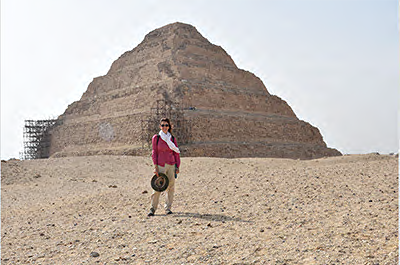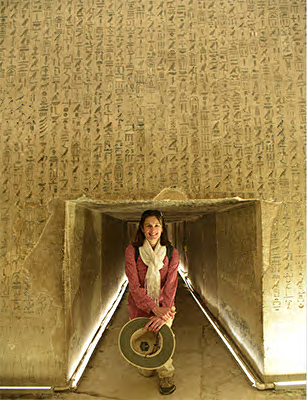The Enduring Power of Ramses The Great
Those who are interested in ancient Egypt and the Pharaohs should reserve a spot for “Era of Gold, Era Of Empire,” Egyptologist and UCSC history professor Elaine Sullivan’s talk on Sunday, October 2, at the Museum of Art and History in downtown Santa Cruz.

Ramses the Great has been dead for 3,235 years, but this powerful Pharaoh still keeps a hold on the public imagination. Look at the long lines at the de Young Museum in San Francisco, which is now hosting the exhibition “Ramses The Great And The Gold Of The Pharaohs,” on display through February 12.
Crowds at the de Young are staring at sarcophagi, puzzling over mummified cats and lion cubs, and admiring the colossal stone Ramses the Great head at the beginning of the exhibition.
Those who are interested in ancient Egypt and the Pharaohs and want to get a vivid cultural, religious, and political context for the ancient artifacts on display at the de Young should reserve a spot for “Era of Gold, Era Of Empire,” Egyptologist and UCSC history professor Elaine Sullivan’s talk on Sunday, October 2, at the Museum of Art and History in downtown Santa Cruz.
The talk is organized by The Humanities Institute of UCSC and co-sponsored by the Santa Cruz Museum of Art and History (MAH) and UC Santa Cruz Special Collections & Archives.
Though the free talk is open to the public, seating is limited, so reservations are strongly encouraged.

Sullivan will delve into the lives and legacies of other major historical figures museum visitors will meet at the de Young show – including the powerful women of his reign such as his ‘great royal wife’ Nefertari and the king’s mother Tuya.
Those who see Sullivan’s talk will also learn about the master craftsman Sennedjem who decorated the royal tombs of Ramses, and the Pharaoh’s imposing father Sety, whose stunning painted wooden coffin is in the show.
“Era Of Gold, Era Of Empire” is a complement to the de Young show. Sullivan calls the show well worth seeing because of its displays of statuary from the New Kingdom and pieces of royal jewelry from other periods of Egyptian history, though she wished that the curation had delved more deeply into the historical context of the objects on display.
The exhibit shows relics from Ramses II’s tomb, as well as an assortment of burial objects from Dashur and Tanis, two incident cities along the Nile.
Sullivan calls “Ramses The Great And The Gold Of The Pharaohs” a rare opportunity to see the artifacts, which are on loan from the Egyptian government.
“Here on the West Coast we don’t have many places where we have access to these kinds of masterworks of Egyptian art,” Sullivan said. “Usually you have to go to New York, Europe, or Cairo.”
Still famous after all these years
It’s no surprise the exhibition has been reeling people in. In terms of public interest and name recognition, Ramses the Great continues to stand out over most of the estimated 170 Pharaohs who ruled Egypt during the Pharaonic Period, which lasted 2,700 years, about 10 times as long as the history of the United States as a country.
When it comes to 21st century notoriety, Ramses the Great – who reigned from 1279 through 1213 BCE – only has one serious rival, King Tutankhamun, Sullivan said.
Ramses II made his mark with many temples, obelisks, and colossal statues of himself. He also expanded Egypt’s empire and augmented power with his wars against the Hittites, including the epic battle of Kadesh, said to be the biggest chariot battle of all time.
In terms of becoming a household name, King Tut has one serious advantage because his tomb was found intact in 1922, at a time when most other known tombs had been looted and in some cases emptied out completely.
“But Ramses the Great had two big things going for him,” Sullivan said. “One is his long reign. He ruled for more than 60 years as part of the 19th Dynasty, which physically allowed him so much time to build and stamp his name across the country, and he was an incredibly prolific builder.”
The second major factor is the Pharaoh’s astonishing penchant for self-promotion and mythologizing, Sullivan said.
“Ramses not only built monuments; he also had his name inscribed on the monuments of his ancestors,” Sullivan said. “And when he did that, it was his way of saying, ‘I am the new king, and your rightful successor.’ He’d sort of insert himself into the narrative in all of these different spaces, even if it was something he didn’t bother to build himself.”
When Egyptologists started figuring out how to translate hieroglyphs, they started seeing the name Ramses again and again, Sullivan said. Ramses was also a larger-than-life figure because was given a combination of lofty roles that tended to be split up in other societies. He was a political ruler but also the top military general, as well as the high priest of Egypt.
“His artwork is both religious and political; it’s aimed at the gods, and at the elites of ancient Egyptian society,” Sullivan said. “It’s also aimed at the majority of people in ancient Egypt, who could not read. Those big images on monumental buildings were a form of communication in a non-literate world. There are scenes of him defending Egypt against chaos, against outsiders.”
Trying to understand the perspective of the ancients
Museum-goers will notice the amount of lavish decoration that went into the monuments and temples of the Pharaohs but also their tombs. Sullivan will delve into the reasons for this attention to detail. “Really, the artwork of ancient Egypt is both outwardly facing – sending a political message – but it also has a political and religious message. Ramses the Great was seen as a semi divine king and a son of the gods.”
Visitors may find it somewhat harder to understand why other examples of art that were never meant to be seen by anyone had a similar painstaking amount of detail.
Why go through so much trouble when the tombs of the dead were shut and sealed away after each powerful king’s demise?
One reason has to do with the fact that the objects were thought to have carried a spiritual power that would continue through the ages. “Those objects in a sense were spells that protected the king, allowing him to regenerate,” Sullivan said. The tomb inscriptions protected the king’s eternal spirit or “ka.”
“Those were spells that protected his body, that allowed him to reach and to become a god in the afterlife, and to be reborn every day along with the sun,” Sullivan explained.
Gossip and complaint: the “Post-It notes” of ancient Egyptian artisans
One room in the de Young exhibition will give museum-goers a rare look at the lives, perspectives, gossip, and complaints of artisans who decorated the tomb of Ramses the Great. Highly educated and painstakingly trained, but not from the elite classes of politicians or royal administration, these artisans were stonecutters, painters, carpenters, and scribes.
Sullivan said she wished the show had delved more deeply into the lives of those artisans, who used pieces of limestone flakes to write down informal notes to communicate with others. “We would think of it as ancient Post-It notes,” Sullivan said. “They would just write down ‘laundry dropped off with the cleaners, this many items’ or ‘this is what I paid you for making me that piece of furniture.’’’
When artisans were finished with those notes, eventually they were tossed down a dried-up well that was used as a garbage bin – and there they stayed for millennia.
“When archaeologists found those notes, all of a sudden we had all this information about what these people did and who they were,” Sullivan said. “Archaeologists have been able to build family trees based on the information.”
Some notes are hilarious even now.
“They complain about everyone who’s living in the village, and there’s one guy who’s sleeping with everyone’s wife, and they’re all furious at him, and there are notes showing that people are knocking off work and pretending to be sick,” Sullivan said. “So we just see all of those kinds of human beings that we want to know about the ancient world.”
A three-dimensional look into the ancient world
During her talk, Sullivan will briefly take MAH patrons into a model of Ramses’ Abu Simbel temple. In her own research, Sullivan uses 3D computer imaging to create intricate models of ancient sites, like the temples of Karnak and the cemetery Saqqara, both of which underwent significant construction during Ramses’ reign. She uses 3D technologies to visualize archaeological sites across space and time, giving us a new perspective of these ancient places.
She was awarded the 2020 Roy Rosenzweig Prize for Innovation in Digital History by The American Historical Association (AHA) for her project Constructing the Sacred: Visibility and Ritual Landscape at the Egyptian Necropolis of Saqqara.
This publication is among the first to push the boundaries to include interactive 3D models that can be navigated both spatially and temporally. It was published earlier this year by Stanford University Press as part of their new series of monographs and scholarly publications.
“These technologies help us draw inferences about what these places look like, the same way I imagine people making tremendous inferences from looking at a fossil,’’ Sullivan said. “I feel like 3D modeling is the closest thing I can imagine to the ability to time travel, because it allows me to reimagine and consider spaces that no longer exist.”
Register here to reserve your spot for Sullivan’s free talk. Visit the deYoung Museum’s website to reserve tickets for the Ramses the Great exhibition in San Francisco.
Original Link: https://news.ucsc.edu/2022/09/ramses-the-great-talk-sullivan-danwhite.html
